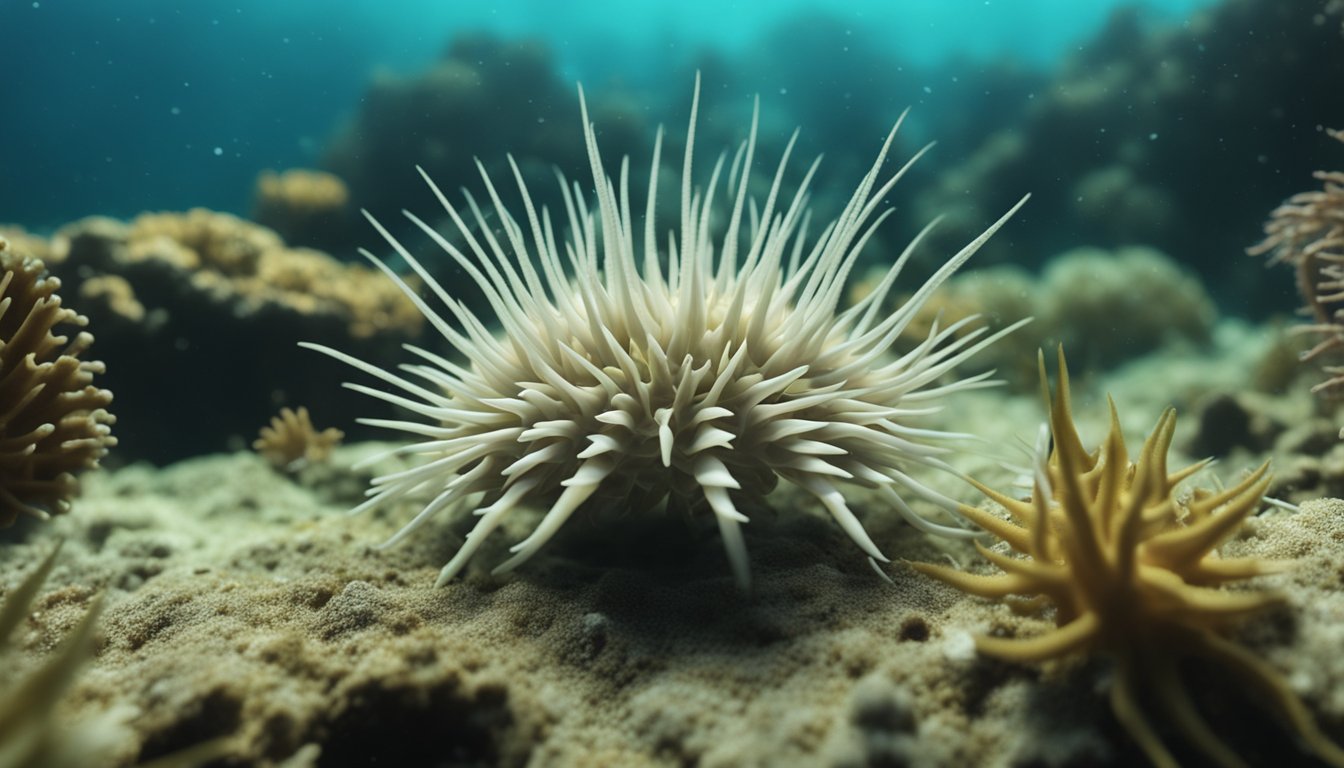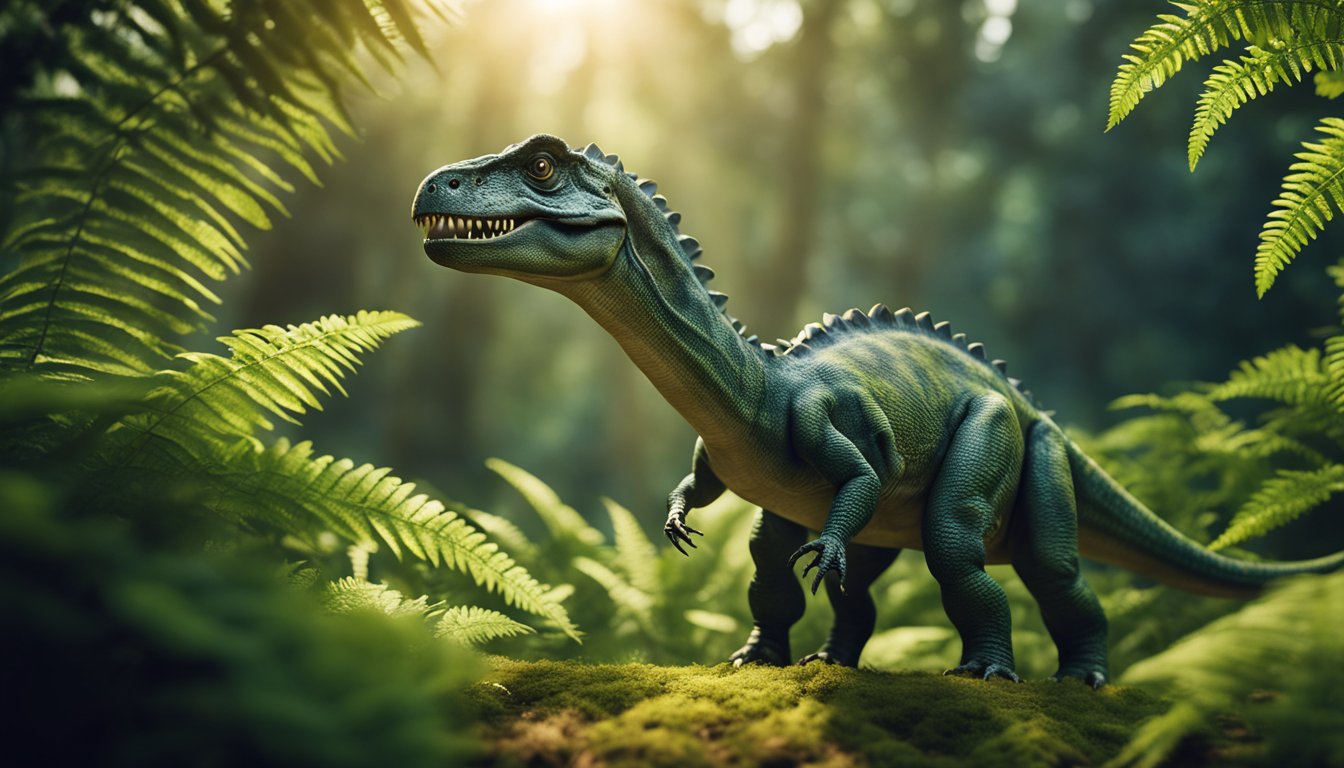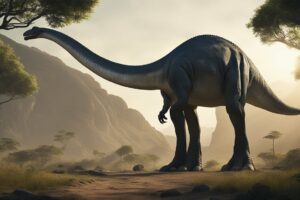Hallucigenia is a creature that lived over 500 million years ago during the Cambrian period, a time when life on Earth was rapidly evolving.
This enigmatic animal has puzzled scientists for years due to its bizarre appearance, which includes a spiky body and long, thin legs.
Despite its strange appearance, Hallucigenia is an important creature in the study of evolution, as it provides insight into the early stages of animal development.

Fossils of Hallucigenia were first discovered in the Burgess Shale of British Columbia in 1977, and since then, scientists have been working to understand this curious creature.
One of the most fascinating aspects of Hallucigenia is its unusual body plan, which has led to much debate among scientists.
Some believe that it is related to modern-day velvet worms, while others think that it is more closely related to arthropods.
Despite this ongoing debate, there is no denying that Hallucigenia is a unique and fascinating creature that has captured the attention of scientists and the public alike.
Unveiling the Mystery: Hallucigenia’s Discovery
Burgess Shale and the Fossil Record
Hallucigenia is a strange animal that lived more than 500 million years ago during the Cambrian period.
It was discovered in the Burgess Shale of Yoho National Park in western Canada, one of the world’s most famous fossil sites.
The Burgess Shale is known for its exceptional preservation of soft-bodied animals, which are usually not fossilized.
The discovery of Hallucigenia was significant because it helped scientists understand how animals evolved during the Cambrian period.
Before Hallucigenia was discovered, scientists thought that it was impossible for an animal to have spikes on its back and legs.
However, Hallucigenia proved them wrong. It had seven pairs of spines on its back and a row of spikes on each of its legs.
The Role of the University of Cambridge
The discovery of Hallucigenia was made possible by Dr. Martin Smith, a paleontologist at the University of Cambridge.
Dr. Smith was studying fossils from the Burgess Shale when he noticed a strange-looking animal that had never been seen before.
He named it Hallucigenia because it looked like something out of a hallucination.
Dr. Smith and his team used a technique called X-ray microtomography to create 3D images of the fossil.
This allowed them to see details that were not visible to the naked eye.
The images revealed that Hallucigenia had an elongated head with a pair of simple eyes, which sat above a mouth with a ring of teeth.
In addition, Hallucigenia’s throat was lined with needle-shaped teeth, which it used to catch and eat small animals.
In conclusion, the discovery of Hallucigenia was a breakthrough in the study of animal evolution.
It showed that animals during the Cambrian period were much more diverse and complex than previously thought.
The discovery also highlighted the importance of the Burgess Shale and the fossil record in helping scientists understand the history of life on Earth.
Decoding Hallucigenia’s Bizarre Anatomy

Hallucigenia is a spiky enigma that lived over 500 million years ago during the Cambrian period.
This creature’s unique anatomy has puzzled scientists for decades.
However, recent studies using electron microscopes have helped decode some of its physical traits.
Spikes, Legs, and More: The Physical Traits
Hallucigenia was a worm-like creature that measured up to 3 cm in length. Its body was covered in spines, which were once thought to be legs.
However, further analysis revealed that Hallucigenia had seven pairs of legs, each with sharp claws that it used to crawl across the ocean floor.
The creature’s body was divided into two distinct regions: the front half and the back half.
The front half had a series of spikes or tentacles that it used to capture prey.
The back half had seven pairs of legs, each with sharp claws that it used to crawl across the ocean floor.
The Curious Case of the Head and Tail
One of the most intriguing aspects of Hallucigenia’s anatomy is its head and tail.
Initially, scientists thought that the spines on one end of the creature were its head, and the legs on the other end were its tail.
However, further analysis revealed that the spines were actually part of its tail, and the creature’s head was located at the opposite end.
Hallucigenia’s head was small and had a mouth with no teeth. It is believed that it fed on small organisms that it captured with its tentacles.
The creature’s eyes, if it had any, are unknown.
In conclusion, Hallucigenia’s bizarre anatomy is a testament to the incredible diversity of life during the Cambrian period.
Its spiky body, seven pairs of legs, and curious head and tail make it a fascinating subject for scientific study.
Hallucigenia’s Place in Evolutionary History

Linking Ancestors: From Water Bears to Velvet Worms
Hallucigenia is a spiky enigma that has puzzled scientists for many years.
It is an extinct genus that lived during the Cambrian period, approximately 500 million years ago.
Hallucigenia is considered to be a key organism in the evolutionary history of animals.
Scientists believe that it is closely related to velvet worms and water bears, two groups of animals that are still alive today.
Water bears, also known as tardigrades, are tiny animals that are found all over the world.
They are known for their ability to survive in extreme conditions, such as high pressure, low temperature, and even in the vacuum of space.
Velvet worms, on the other hand, are soft-bodied animals that are found in tropical and subtropical regions.
They are known for their ability to shoot sticky slime at their prey, which immobilizes them.
Hallucigenia shares many characteristics with both water bears and velvet worms.
It has spines on its back, which are similar to the spines found on water bears. It also has legs, which are similar to the legs found on velvet worms.
These similarities suggest that Hallucigenia is an ancestor of both water bears and velvet worms.
Exploring the Cambrian Explosion
The Cambrian period is known as the “explosion of life” because it was a time when many new animal groups appeared on Earth.
During this time, the first animals with hard shells, such as trilobites, appeared.
It was also a time when animals with complex body plans, such as Hallucigenia, appeared.
Scientists believe that the Cambrian explosion was caused by a combination of factors, including an increase in oxygen levels, the evolution of new predator-prey relationships, and the evolution of new body plans.
The evolution of new body plans allowed animals to occupy new ecological niches, which led to an increase in diversity.
Hallucigenia’s place in the tree of life has been a subject of debate for many years.
However, recent studies have shown that it is closely related to velvet worms and water bears.
This discovery has helped scientists to better understand the evolutionary history of these groups of animals.
In conclusion, Hallucigenia is an important organism in the evolutionary history of animals.
Its spiky appearance and unique characteristics have fascinated scientists for many years.
By studying Hallucigenia, scientists have been able to better understand the evolution of animal groups such as water bears and velvet worms, as well as the Cambrian explosion.
Hallucigenia’s Impact on Science and Culture

Inspirations in Modern Science
Hallucigenia has been a source of inspiration for scientists for decades.
The discovery of this enigmatic creature has contributed significantly to our understanding of the evolution of life on earth.
Dr. Jean-Bernard Caron, a paleontologist at the Royal Ontario Museum, was one of the researchers who helped to identify the creature.
In a journal Nature paper, he and his colleagues described how they used new imaging techniques to study the fossilized remains of Hallucigenia.
Their findings revealed that Hallucigenia had a unique set of features, including an elongated head with a pair of simple eyes and a mouth with a ring of teeth.
The creature’s throat was also lined with needle-shaped teeth.
These discoveries have helped scientists to better understand the diversity of life during the Cambrian period.
Hallucigenia in Popular Imagination
Hallucigenia’s unusual appearance has captured the imagination of people around the world.
The creature’s spiky body and bizarre features have made it a popular subject in science fiction and fantasy literature.
It has also been featured in a number of documentaries and television shows, including the Smithsonian Institution’s “Prehistoric Road Trip.”
Despite its popularity in popular culture, Hallucigenia remains a mysterious and enigmatic creature.
Its unique set of features has inspired scientists and artists alike, and its discovery has helped to shed light on the complex and fascinating history of life on earth.
Fun fact: The name “Hallucigenia” was chosen because of the creature’s unusual appearance, which was said to resemble a hallucination.
Frequently Asked Questions

What are the unique features of Hallucigenia fossils?
Hallucigenia fossils are unique due to their strange and spiky appearance.
They have long, slender bodies covered in rows of spines, and their heads are adorned with a pair of simple eyes and a ring of needle-shaped teeth in their throats.
These fossils have puzzled scientists for decades, and their bizarre anatomy has made them a subject of fascination for paleontologists.
How did Hallucigenia defend itself in its environment?
It is unclear how Hallucigenia defended itself in its environment.
However, its spiky appearance suggests that it may have used its sharp spines as a form of defense against predators.
These spines may have also helped it to move through the sediment at the bottom of the ocean, where it lived during the Cambrian period.
Can you explain the role of Hallucigenia in understanding evolutionary history?
Hallucigenia plays an important role in understanding the evolutionary history of animals.
Its unique anatomy has provided scientists with valuable insights into the early stages of animal evolution and the development of body plans.
Hallucigenia is a key example of the diversity of life during the Cambrian period, which saw the emergence of many new and unusual animal forms.
What habitat did Hallucigenia thrive in during the Cambrian Period?
Hallucigenia thrived in the ocean during the Cambrian period, which lasted from about 541 million to 485 million years ago.
During this time, the oceans were teeming with life, and many new and unusual animal forms emerged.
Hallucigenia lived on the ocean floor, where it likely fed on small organisms and detritus.
How big was Hallucigenia, and how does its size compare to modern creatures?
Hallucigenia was a small creature, measuring between 10 and 50 millimeters in length.
This is much smaller than many modern animals, such as whales or elephants, which can grow to be many meters in length.
However, Hallucigenia’s small size did not prevent it from being an important player in the ecosystem of the Cambrian period.
What mysteries does Hallucigenia present to paleontologists today?
Despite decades of study, Hallucigenia continues to present many mysteries to paleontologists.
Its unusual anatomy and behavior have led to many questions about its place in the tree of life and its role in the ecosystem of the Cambrian period.
Scientists continue to study Hallucigenia fossils in order to uncover new information about this enigmatic creature and the early history of life on Earth.






